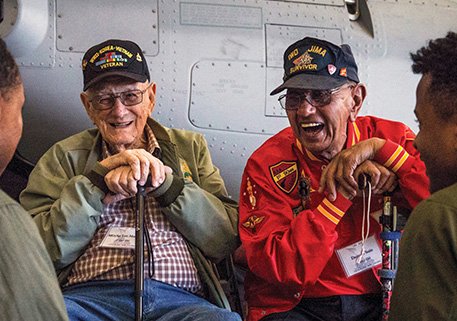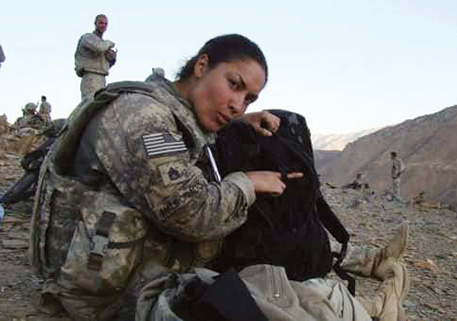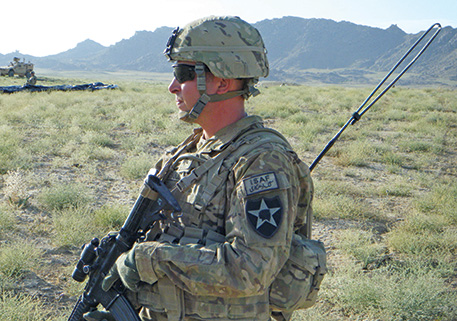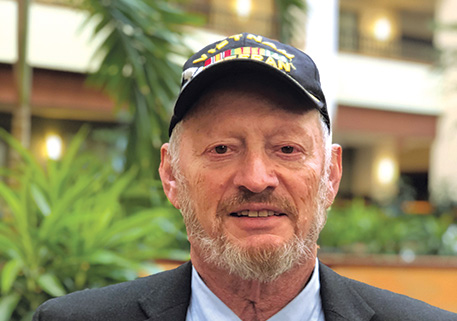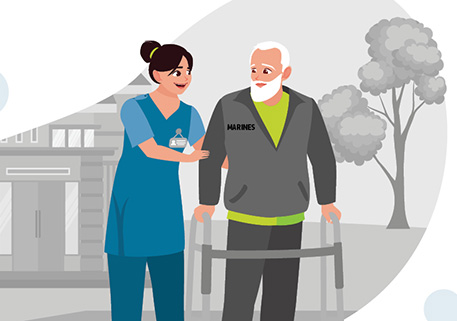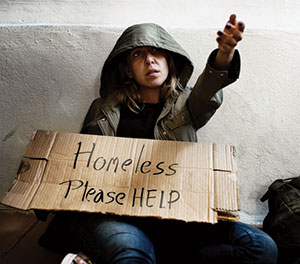 Jennifer Badger had been out of the Navy for more than a decade when the circumstances in her life led her into homelessness.
Jennifer Badger had been out of the Navy for more than a decade when the circumstances in her life led her into homelessness.
When she enlisted in May 2001, she was looking for a change and a way out of her hometown of Fulton, Missouri. She became an intelligence specialist and deployed to the Persian Gulf in 2002 on the aircraft carrier USS George Washington.
In 2005, she decided to transition back to civilian life. She had become a single mother and wanted to raise her son without worrying about deploying again.
In the years that followed her separation from the military, circumstances and choices led Badger down a troubled path of drug addiction, abusive relationships and depression. She went to prison in 2019 and got high the day she was released.
At that point, she said her family had given up on her.
“I lost everything,” Badger said. “I lost all three of my children. I lost everything but my life.”
With nowhere to go, she became homeless. She slept on friends’ couches. She continued to use drugs. She eventually nearly died from an overdose.
Badger’s story is one in a concerning trend among women veterans.
A growing problem
With women now comprising 15% of active-duty forces and 19% of reserve units—a number that continues to rise—they have become the fastest-growing segment of the veteran population.
Yet, the availability of services offered to women veterans at risk for homelessness has not kept pace with their increasing numbers.
According to the Department of Veterans Affairs, women transitioning from the military can face many challenges when returning to civilian life that put them at risk for homelessness: single parenting, domestic abuse, psychological aftereffects related to military sexual trauma (MST) or combat, substance abuse, employment and affordable housing.
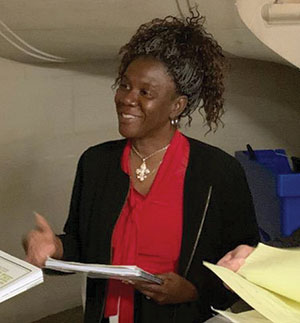

Searching for help
Despite experts knowing the needs, many women may find it challenging to know where to go to find help.
This was the case for Army veteran Penni Lo’Vette Brown.
She said the post-traumatic stress and MST she suffered was initially untreated after she left the military.
“My marriage is something I was not prepared for,” Brown said.
There was domestic violence, and she needed to find protection for herself and her three young children. But she felt she had nowhere to turn.
“In 1999, I became homeless with three babies on my hip,” Brown said.
She made more than two dozen calls looking for a shelter that would allow her to bring her children. Brown said her children’s safety was paramount, and she’s not sure she would or could have left her husband without that assurance.
She finally found an emergency shelter in Santa Barbara, California, where she took her children. A month later, she moved to a different shelter in nearby Lompoc that offered access to permanent and affordable housing options. She entered the VA’s Veterans Readiness and Employment (formerly known as Vocational Rehabilitation and Employment) program, where she trained and became a barber. And after two months, she was able to move into an apartment near her children’s school using the Housing Choice Voucher Program through the U.S. Department of Housing and Urban Development. She later received treatment for PTSD from the VA.
For Badger, not long after her near-fatal overdose, she decided she was done and looked for any place that would help her.
“I woke up one day and just knew this was not me,” she said.
Badger had realized she was the same age her father had been when he died from a drug overdose and didn’t want her children to experience what she had gone through.
“I needed my kids to have a success story because my dad did not have a comeback story,” she said.
When she finally decided to seek help, she called any number she could find. In her search, Badger was eventually pointed to Welcome Home Inc., a homeless veterans program in central Missouri that receives financial support from the DAV Charitable Service Trust.
“I feel like if there was no Welcome Home,” Badger said, “I would probably still be homeless and using or back in prison or dead.”
Tammy Scott, a caseworker and the organization’s permanent housing program coordinator, was the one who answered the phone, picked Badger up and brought her in.
Scott said up to eight women can stay at the 34-bed facility. It has four permanent rooms designated for women in a locked hallway segregated from the men. Two additional flex rooms can accommodate families or women, depending on current demand. There’s 24/7 camera monitoring, too.
Scott said providing an environment where women feel safe is crucial to getting them help. Women who come to her program, more so than men, come from abusive relationships. They are more likely to have MST in their background or unmet mental health issues.
To escape homelessness, Brown said, women veterans with children do need the VA health care and benefits for themselves and state medical benefits for their children.
Limited options
Both Brown and Badger were fortunate to find homelessness services available to them. They were connected to programs or shelters in their area, but that’s not always an option. Homelessness among women veterans is on the rise, but help can be limited, hard to find or nonexistent.
While Badger had used the VA for some medical care in the past, she didn’t know about its breadth of resources for homeless and at-risk veterans and that she qualified for them. But because Welcome Home partners with the VA, each of its residents gets a representative from the VA’s Health Care for Homeless Veterans program. This means residents have an entry point to veterans benefits such as medical care, mental health care and even substance abuse counseling.
Badger took advantage of these VA programs and services to get sober and start rebuilding her life.
Decades after her own struggles, Brown now counsels at-risk women veterans as the DAV Department of California women veterans adviser.
When she experienced homelessness, Brown didn’t reach out to the VA for assistance. Her focus was on her children, not her military background. She said this is a common mindset among the women she talks to, with many staying in abusive relationships rather than risking becoming homeless. They don’t tend to seek out VA benefits when they find themselves in a housing crisis. They look in their community for anything that may help.
Brown points women veterans to federal, state Homeless Veteran Stand Downs California, including homeless veteran stand downs and a regular bus shuttle program. Buses take homeless veterans to women’s clinics and other VA medical care. The bus program is especially targeted at those living in rural areas miles away from specialty care in bigger cities. She also designed MST training for chapters in California that focuses on how the issue is not gender-specific.
What the VA does
Homelessness and housing insecurity is an issue facing communities across the country. While the VA has made significant strides in addressing this issue, more needs to be done for women veterans.
“With greater numbers of women serving in the military and the greater likelihood of women veterans being single parents, new and more comprehensive housing and child care services are needed,’’ said Joy Ilem, DAV’s national legislative director. “DAV will continue to advocate for VA to improve outreach to women veterans and ensure VA provides equitable access to programs, facilities and services that meet their distinct needs and ensure that they feel safe and welcomed.”
What the VA is doing includes its Supportive Services for Veteran Families program, which connects low-income veterans to nonprofits to get them into housing. The program typically provides eviction prevention or rapid rehousing, including the first month’s rent and utility and security deposits. The VA credits the program with keeping 19,200 children and 10,500 households together in fiscal year 2021.
The VA also offers a spate of other programs, including the Housing Choice Vouchers Brown used to pull herself out of homelessness. The vouchers pay a subsidy to landlords on behalf of veterans. Veterans typically pay up to 30% of their income for rent. VA statistics show that nearly 11,000 women veterans were helped last year through the Housing Choice Voucher Program. The grant program to community-based agencies serving homeless veterans served more than 1,300 women veterans in 2021.
VA programs specific to women veterans include the Center for Women Veterans. The center coordinates the VA’s administration of health care, benefits, services and programs for women veterans. The center has a hotline for women at 855-829-6636. The VA also offers the the rate of homelessness among women veterans increased.
“The downside to all of the VA’s homeless veteran programs is that they don’t cover communities across the United States equitably,” Illem said. “They tend to cover areas with higher veteran populations.”
Advocacy in action
Homelessness is a major concern for DAV at all levels.
Both the Charitable Service Trust and Columbia Trust provide funding to the DAV Homeless Veteran Initiative, which promotes partnerships and collaboration at all levels of government to develop assistance programs.
The Charitable Service Trust also financially supports many organizations that help veterans experiencing homelessness, distributing more than 100 grants totaling nearly $3.8 million over the past five years.
DAV departments and chapters coordinate and participate in Homeless Veteran Stand Downs at various locations throughout the country. These outreach events, said Voluntary Services Director John Kleindienst, are meant to connect homeless and at-risk veterans with community resources and assistance, including employment, legal, housing, medical and veterans benefits.
These stand downs also provide veterans with assistance to address some potential underlying causes of homelessness. Benefits advocates are on hand to provide VA disability claims processing support and to educate attendees on employment opportunities such as DAV’s job fairs.
Kleindienst said there are always women-specific VA medical services, clothing and hygiene items available to event attendees.
“It’s heartbreaking to think of even one veteran being on the street, and an increase in homelessness for women veterans sets off a lot of alarm bells,” he said. “We see them at the events we’ve hosted at headquarters and try to make an extra effort to ensure their unique needs are met. Women have historically been underserved, and their vulnerability often extends to the children they support.”
Moving forward
Today, Brown is commander of DAV Chapter 91 in Lompoc. She also owns a barbershop that doubles as her office where she counsels women veterans daily on homelessness and MST claims. She’s enrolled in law school. Her children are now grown and enjoying successful careers.
She works to get women veterans into emergency shelters in communities where there can be long waitlists for beds. There are still only a few emergency shelter options for women with children.
She said she was blessed, but she also put in the hard work to ensure her experience was temporary.
“It was a tenacity,” Brown said. “I had babies that I had to make sure were OK.”
In Missouri, Badger is still early in her recovery journey but said she’s doing well because of the care she received and the effort she put in to get sober. She has her own apartment and works at the Harry S. Truman Memorial Veterans’ Hospital in Columbia as a travel clerk.
She has aspirations to put her bachelor’s degree in human services to work, too, by becoming a peer support specialist at the VA. She said she noticed there aren’t many women filling this role—none where she’s located—and wants to be an example for other women veterans to follow.
“If I can do this in six months, what can I do in a year?” she said.
Editor’s note: The printed magazine version of this article incorrectly states there are 80 beds available at Welcome Home, Inc.


